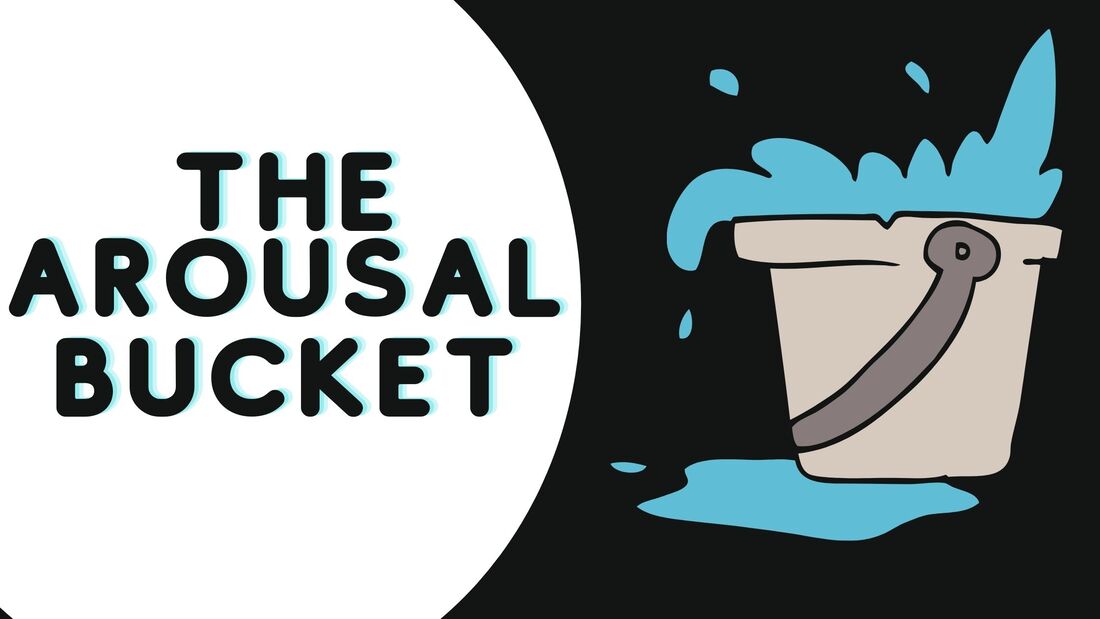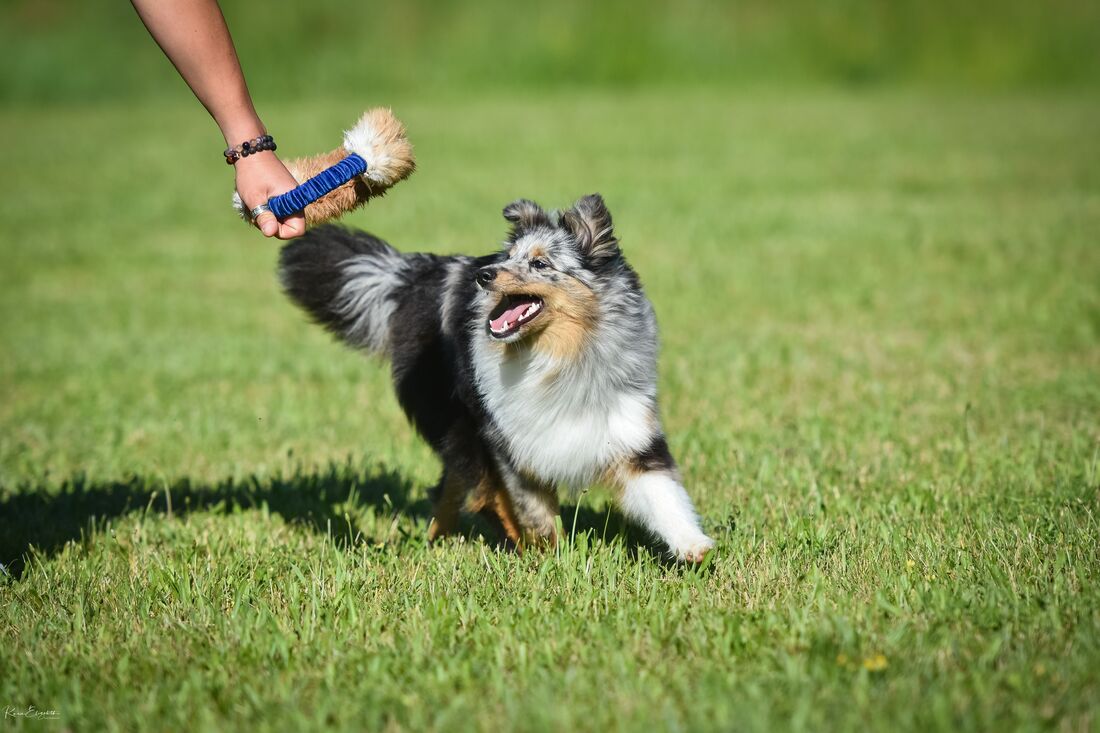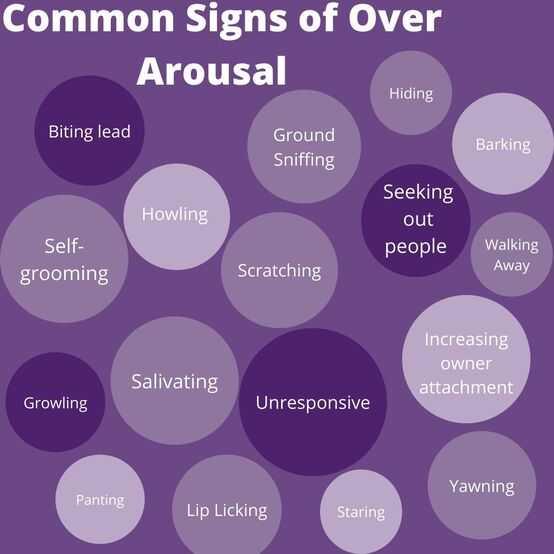|
Does your dog struggle with over arousal? Is your dog easily excitable? Are your training sessions an exercise in patience? If you answered yes to any of those questions, you are not alone! Over the past year, many of you have seen Miss Keeper on my various social media platforms learning and perfectly her canine conditioning foundation skills. What you haven’t seen is some of my struggles to manger her over arousal and keenness for everything in life. She is eager, full of life, intense and insanely drivey - all the things I want in my up and comer agility dog. Learning to harness this arousal when asking for prevision work in Keeper's canine conditioning ventures has taken some time to figure out and has led to some frustration times/sessions along the way. In dog sports, you’ll often hear people talk about high drive as a coveted feature of top canine athletes but high drive dogs can be a LOT to handle! Learning to live and work with a high drive dog was something completely new to me and at times overwhelming! Over the past year, with the help of experienced trainers and friends, I have learned a variety of tools to help manage my excitable 10 lbs puppy!! With their advice I was able to change my entire mentality at how to approach everyday life and training (i.e. sport specific training/conditioning work) with Keeper to maximizes our success and limit both our frustrations! With new tools in my toolbox, I was armed and prepared for “most” situations!! As a result, my frustrations drastically lowered and we became a better team in life, sport training and conditioning. So how can we have a high drive dog and still find success in canine conditioning? In this week’s blog I review some simple strategies that I have learned to help manage my dog’s arousal level in both the canine gym and life! What is ArousalWhen I talk about arousal what I’m really referring to is the physiological and psychological state of the dog's brain activity. A highly aroused dog will generally have a high heart rate, blood pressure, and respiration. They may drool excessively, may have dilated pupils, and will have poor impulse control in response to stimulus in general – making them easily distracted! There are a number of neural pathways within the brain that regulate and enable our brain’s communication between the nervous system and hormonal system. When our dogs are “aroused” their brain is more “awake” and therefore responsive to external stimuli. Arousal can have a large impact on our dog’s body and in their performance but it’s not a binary switch! Our dogs don’t shift from no arousal to high arousal – instead there is a gradual build-up or a gradual reduction in arousal. Too much arousal can also derail our training session! The more aroused our dog is the closer they’re pushed to their threshold. The “threshold” is the point in which our dog’s focus and ability to respond is negatively affected and we’re more likely to see our dogs react with unwanted behaviours. Not all dogs are the same! Some dogs are over-aroused easily while others struggle to find it. As handlers, we may assume our dogs are being stubborn when actually they may be experiencing a state of arousal that makes it difficult to process commands. The difference between “high drive” and “arousal” Dogs with good “drive” are highly valued in dog sports because it generally means our dog has focus and commitment to a specific goal. Arousal is a side effect of drive and can be characterized by a dog that is easily distracted – moving from one distraction to the next without really “locking” on to a task. Have you heard of the Yerkes-Dodson Law? The law describes the relationship between pressure and performance. As arousal increases, so does performance, until which our dog reaches the optimum level (called “in drive”) at which time, any additional arousal pushes our dog past their threshold and performance begins to become impaired. Arousal can also affect our dog’s performance in conditioning. With too much arousal our dogs will have a lack of patience for holding position for various lengths of time, as well as, they’ll have difficulty getting into proper position or become easily distracted. The “Arousal” Bucket  I’m a huge fan of the Absolute Dogs courses and they have some excellent information on dog behaviour and arousal in particular. One analogy of theirs that really resonates with me is the Arousal Bucket. Picture a bucket. Every time your dog experiences an event that triggers a positive or negative stress/arousal picture a cup of water being added to their bucket. For example, an agility run, or a bad interaction with another dog would both contribute water to the arousal bucket. As more water is added to the bucket the closer our dog gets to their threshold. Reactive dogs and many high drive dogs often have small buckets – it doesn’t take much for their bucket to “overflow” and push them past their threshold! Once dogs hit their threshold their water will spill over – if our dog is too excited this will result in inefficient over-arousal and if our dog is a worrier then this may become replaced with fear. All though arousal is stressful for your dog it doesn't mean the stress they’re experiencing is BAD. Our dogs can experience a type of stress called eustress or beneficial stress. Humans can experience eustress when riding a roller coaster or encountering a fun challenge. Likewise, you dog can also experience positive stress from a good agility run or from playing with their owner or other dogs. This stress response causes physical changes in the body, which releases stress hormones into the bloodstream. These stress hormones don’t just go away as soon as the stimulus has passed. Did you know it can take up to 72 hours for a dog’s arousal rate to return to normal? This is why it’s not uncommon to see a “short fuse” with dogs that had a recent fight as they can remain in a high state of arousal for days after the event. If you dog is experiencing daily stress (either negative or positive) that means new stress hormones are added each day, prolonging the return to normalcy period. So, what do we do if our dog pushes past their “in drive” threshold and becomes too aroused during our canine condition sessions? High arousal in the canine gym can be especially difficult to manage as we’re often looking for precise movements, holding positions, and asking for heightened body awareness which requires careful thinking from our dogs. What does high-arousal look like in dogs? The optimal level of arousal builds intensity into behaviours that can lead to improved confidence, precision and speed! These are all key qualities for a successful canine athlete! The ability to moderate arousal and being able to think in arousal is critical to this success. But too much arousal can be a detriment to performance leading to a dog who cannot think nor listen to their handler. A few examples of a dog struggling to think in arousal in sport or in conditioning might include:
What are the benefits of a dog who can think through arousal? The benefits include:
To help our dogs find success managing their arousal we need to teach them the ability to go between high and low arousal states during a training session. Different levels of arousal are needed for different types of tasks. The more precise or complex the task being taught the lower the level of arousal is needed to allow the dog to learn the task. There is a difference between being willing and happy to work and high levels of arousal all though they can be tied together. Learning your dog and what the optimal state of arousal is for the task at hand is very important to achieve success. Strategies for Managing High Arousal Starting to understand your dog’s arousal levels and how to bring them up or down is an important step in the foundations of any training including both sports and canine conditioning. Focusing on this as a young dog before tackling any complex tasks will yield you the best results. If this is something that is new to you and your dog the best place to start working on modulating arousal is to focus on it completely separate of any new tasks. You can begin with behaviours that are simple and are easy for your dog. For example, if your dog already understands an exciting game of tug (high arousal) and a sit stay (low arousal) can you bounce back and forth between these two tasks without sacrificing criteria? The analogy of a new pair of jeans in describing high arousal versus low arousal works well when it comes to describing dog behaviour and training. Think of a new pair of jeans. At first, they can be stiff and rigid to put on requiring far more effort on your part. As you wear your jeans over time, it requires less effort to put them (providing we stay the same weight!!!). Exactly the same applies to switching between high and low arousal in dogs. The more a dog practices moving at speed from low arousal to high arousal, and high arousal to low arousal, the easier the switch will be to operate in the future - the switch basically gets looser (T. Mitchell, 2017). Games to Implement The trainers over at Absolute Dogs have some FANTASTIC games that we can use to help our dogs manage their excitement level and get them ready to work on canine conditioning. These games have a variety of uses but what I really like is how they increase engagement with my dog and they’re FUN! I tend to integrate these games into my warm-up prior to staring canine conditioning. Not only will these games help get our dogs ready for the physical challenges of conditioning but they will also get our dogs mentally and emotional ready for work!
Remember, to train the dog you have in front of you! Every dog will have different thresholds and will have “good” days and “bad” days just as we do. If you’re struggling with over arousal – ask yourself what might have contributed to pushing your dog over their threshold? Are we, as their training partner, not giving them the right information and contributing to their frustration and arousal? Is their breed characteristics that might be contributing to their arousal level? For conditioning, I have several strategies for you to implement to help you find more success with your highly aroused dog.
A final word...Chances are, if your dog is highly excitable in the gym, they’ll also experience high excitement in other areas of their life. This excitability may emerge when faced with meeting other dogs and people, seeing prey animals, or arriving at their favorite training venues. Regardless of where your dog experiences their arousal it’s important to manage it and set your dog up for success. This means we need to stay consistent in how we treat high arousal regardless of where it happens in life, sport, or conditioning. At the end of the day, we want our dogs to be excited about doing any sort of work with us. It is fun and we want it to stay that way. But knowing that there is a big difference between fun/excited and over arousal is the first step in seeing the signs of this during a training session. Think of higher arousal level as a layer of proofing. The higher the arousal level we have the harder the dog has to work to be as precise as they were at a lower arousal level. Just like with any proofing we do not want to add a higher level of it in the learning stages of a task. Canine conditioning is not different than any other complex task. We want the dog at an optimal level and have tools available to help them moderate that arousal. This helps alleviate both our frustration and the level of frustration in the dog, allowing us to get more out of a session and getting the result of a happier and healthier dog. SourcesBarnett Stacy (2017). “High Arousal Dogs and Focus” https://scentsabilitiesnw.com/blog/high-arousal-dogs-and-focus/
Mitchell, T (2017). How to be a Concept Dog Trainer. Westline Publishing Limited, United Kingdom. Pro Dog Trainer (2019). “Week 4: Arousal” Absolute Dogs Pro Dog Trainer (2019). “Week 4: Working with Arousal” Absolute Dogs
2 Comments
blanca
7/3/2022 12:33:12 pm
I really liked your blog; my 6-YEAR-OLD little dog is shy, the environment intimidates her despite the work I have been able to accomplish: the big dogs, the big voices; while at home or in agility training, she is happy and asks for more; it is progressing but it is not enough; what do you recommend ? , will you do a blog soon in this direction?
Reply
5/22/2024 10:18:48 pm
Your blog about canine conditioning is quite useful! It's wonderful to see someone freely discussing their experiences with a high-drive dog like Miss Keeper. Your ideas for overcoming arousal and utilizing excitement for training are priceless. Keep up the excellent job!
Reply
Leave a Reply. |
AuthorCarolyn McIntyre Archives
June 2024
Categories
All
|






 RSS Feed
RSS Feed